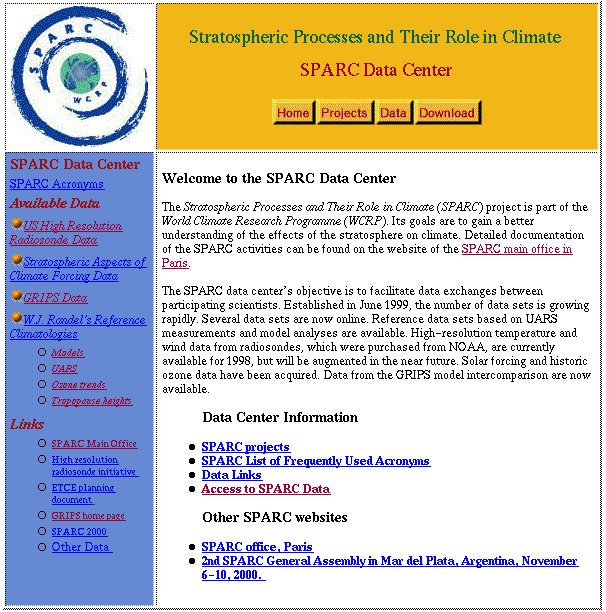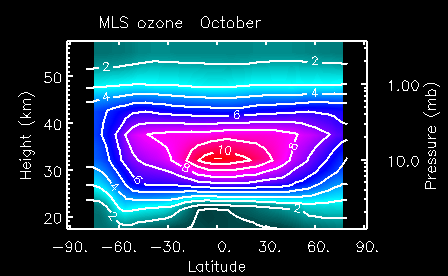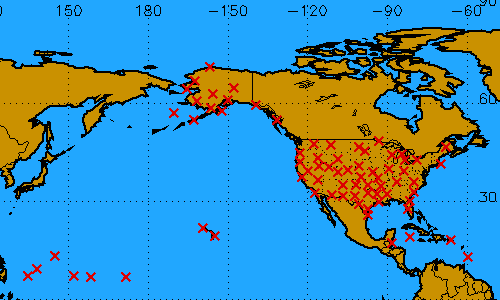 |
Stratospheric Processes And their Role in Climate
|
||||||||
| Home | Initiatives | Organisation | Publications | Meetings | Acronyms and Abbreviations | Useful Links |
![]()
 |
Stratospheric Processes And their Role in Climate
|
||||||||
| Home | Initiatives | Organisation | Publications | Meetings | Acronyms and Abbreviations | Useful Links |
![]()
The SPARC Data Center (SPARC-DC) has been in operation since July 1999. Located at the State University of New York at Stony Brook, it has been established as a resource for the linkage, storage, and exchange of scientific data pertinent to the different SPARC working groups. Furthermore, it is designated to provide simple post-processing and analysis of data for SPARC projects. Funded by NASA, Marvin Geller heads the SPARC-DC as the principal investigator with William Randel and Kevin Hamilton co-investigators. Petra Udelhofen is the scientist responsible for operating the SPARC-DC and will provide an overview over the activities of the data center in its year of inception.
The SPARC-DC computer consists of a fast dual processor workstation, which serves the web at www.sparc.sunysb.edu (Figure 1). Data can be downloaded via the web site or anonymous ftp (atmos.sparc.sunysb.edu, directory: pub/sparc). Several working groups have transferred data to the SPARC-DC most of which are publicly available.

Figure 1: The SPARC-DC’s home page is located at www.sparc.sunysb.edu.
In the last months, the SPARC-DC obtained data describing climate forcing parameters that influence stratospheric change (Karoly, 2000). Robert Portmann provided a combined tropospheric and stratospheric data set by merging the global stratospheric ozone trends data set by Randel and Wu (1999) with the ozone data set by Kiehl et al. (1999). The Randel and Wu data set can also be obtained from the SPARC-DC. Judith Lean contributed reconstruction of solar irradiance from 1610 to present (currently 1999, with yearly updates) (Lean et al., 1995) and high resolution spectral estimates of solar irradiance from 115.5nm to 425.5nm during solar maximum and solar minimum based on satellite measurements (Lean et al., 1997).
Steven Pawson transferred model data from fourteen groups of the GCM Reality Project for SPARC (GRIPS) to the SPARC-DC (Pawson et al., 2000). To make the data readable across platforms, the SPARC-DC converted the binary files into NETCDF. Time series of three-dimensional monthly mean temperature and geopotential height fields and zonal means of temperature and winds are available. Several GCMs provided additional model diagnostics, which vary from one model to the next.
In January 2000, the Water Vapour Assessment (WAVAS) working group decided at a review meeting to archive data sets used in the WAVAS report at the SPARC-DC. These data sets include water vapour measurements from aircraft campaigns, ground measurements, and satellite data. The working group requested to have these data in one location to facilitate access. Originally, the water vapour data were scattered across twenty-three computer sites with eight of them password protected. Now, the SPARC-DC mirrors the data sets and provides a centralised archive. Some water vapour data are restricted in usage following the wishes of the authors. For example, restrictions apply when the original authors have not yet published their data and want to be consulted about further data usage. Directions on how to obtain a password for the restricted data sets are given on the SPARC-DC web site.
At the outset of the SPARC-DC, William Randel provided zonal mean trace gas climatologies for CH4, H2O, O3, HF, HCl, NO2 (sunrise and sunset), NO (sunrise and sunset), ClO, N2O, and HNO3 based on UARS measurements. Web site displays of these data sets were produced at the SPARC-DC (Figure 2). In an ongoing effort for the SPARC Reference Climatology project, Randel derives monthly mean model climatologies (Table 1) which are updated and transferred regularly to the SPARC-DC. Model variables are the monthly and zonal means of temperature, wind, eddy momentum flux, eddy heat flux, EP flux divergence, and geopotential heights. Additional data sets encompass tropopause heights derived from NCEP data.

Figure 2: Example data for the SPARC Reference Climatology Project: Zonal mean ozone mixing ratio derived from UARS MLS data. Contour interval is 1ppmv. (Data source: W.J. Randel; Graph: P.M. Udelhofen SPARC-DC)
|
|
|
|
|
ECMWF |
|
|
|
NCEP-RA |
|
|
|
NCEP-CPC |
|
|
|
UKMO |
|
|
|
NCEP: National Center for Environmental Prediction; RA-Reanalyses; CPC-Climate Prediction Center; UKMO: UK Meteorological Office |
||
Table 1: Monthly Mean Reference Model Data available at the SPARC Data Center (Source: W.J. Randel). Variables include the temperature and geopotential heights (3D Grids) and temperature and zonal mean wind components (zonal average fields). The table summarises the data holdings as of April, 2000. These data sets will be updated periodically to extend the time coverage.
Another ongoing effort at the SPARC-DC is the acquisition and publication of high-resolution radiosonde data for the SPARC Gravity Wave Initiative. Figure 3 shows the station location of US upper air sites that provide radiosonde ascents with measurements every six seconds. The SPARC-DC has purchased radiosonde data from NOAA for 1998 and this data set will be extended for three more years in the near future utilising NSF research funds.

Figure 3: Location of US high-resolution radio sounding stations
The SPARC-DC encourages the different working groups to make use of its facilities. To ensure the portability to different computer systems, these data sets should be formatted in ASCII or NETCDF. Certain binary data may be accepted and converted into NETCDF at the SPARC-DC. The SPARC-DC does not intend to duplicate data when these are available from other data centres, except under circumstances when data mirroring may alleviate access through the Internet. Generally, the SPARC-DC provides linkages to useful existing sites and collects data that are unique to SPARC projects. Typically, the data will be made available to the public. Password-protected access will be provided for data that have not yet been published. However, the SPARC-DC does not intend to distribute data sets that require more complicated data protocols.
In its year since inception, the primary efforts of the SPARC-DC have been on setting up the site, collecting data for the different working groups, and converting them into portable formats. In the future, its focus will shift towards performing data analyses particularly within, but not limited to, the framework of the SPARC Reference Climatology Project.
Karoly, D.J., Stratospheric aspects of climate forcing. SPARC Newsletter, 14, 2000.
Kiehl, J. T., T. L. Schneider, R. W. Portmann, and S. Solomon, Climate forcing due to tropospheric and stratospheric ozone. J. Geophys. Res., 104, 31239-31254,1999.
Lean J., J. Beer and R. Bradley, Reconstruction of solar irradiance since 1600: Implications for climate change. Geophys. Res. Lett., 22, 3195-3198, 1995.
Lean, J., G. J. Rottman, H. L. Kyle, T. N. Woods, J. R. Hickey, and L. C. Puga, Detection and parameterisation of variations in solar mid and near ultraviolet radiation (200 to 400 nm). J. Geophys. Res., 102, 29,939-29,956, 1997.
Pawson, S., Kodera, K., Hamilton, K., Shepherd, T.G., Beagley, S.R., Boville, B.A., Farrara, J.D., Fairlie, T.D.A., Kitoh, A., Lahoz, W.A., Langematz, U., Manzini, E., Rind, D.H., Scaife, A.A., Shibata, K., Simon, P., Swinbank, R., Takacs, L., Wilson, R.J., Al-Saadi, J.A., Amodei, M., Chiba, M., Coy, L., deGrandpré, J., Eckman, R.S., Fiorino, M., Grose, W.L., Koide, H., Koshyk, J.N., Li, D., Lerner, J., Mahlman, J.D., McFarlane, N.A., Mechoso, C.R., Molod, A., O'Neill, A., Pierce, R.B., Randel, W.J., Rood, R.B., and F.Wu, The GCM-Reality Intercomparison Project for SPARC (GRIPS): Scientific Issues and Initial Results, Bull. Am. Meteorol. Soc., 81, 781-796, 2000.
Randel, W. J., and F. Wu, A stratospheric ozone trends data set for global modeling studies. Geophys. Res. Lett., 26, 3089-3092, 1999.
![]()